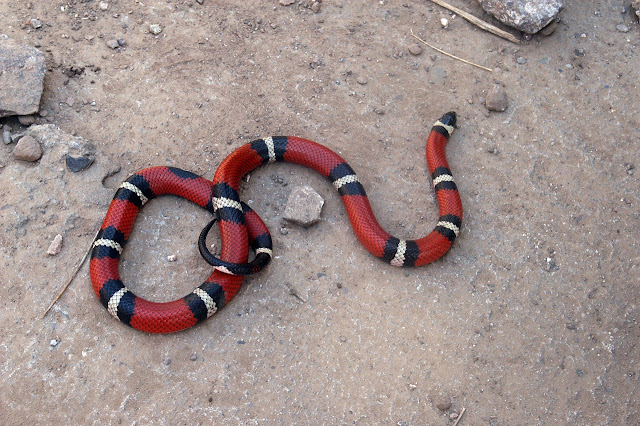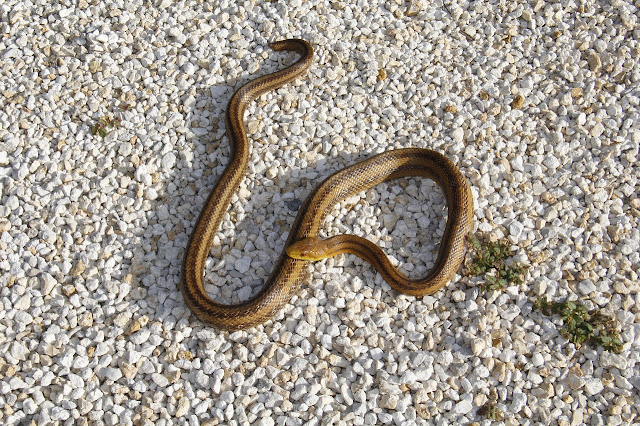Texas coral snake
Identification
The coral snake or 'coral snake' is wary and rarely seen.
These snakes possess one of the most powerful poisons.
There are four types of poisonous snakes in Texas: coral
snakes, copperheads, cottonmouths (water moccasins), and rattlesnakes.
The coral snake or coral snake is shy and is rarely seen.
These snakes possess the most potent venom of all North American snakes, but
they are also among the least dangerous.
It is the only venomous snake in Texas that has bright colors
of red, yellow, and black that completely surround the body.
Because the harmless snakes, the Texas scarlet snake, and Louisiana and Mexican milk snake, share the pattern of red, black, and yellow,
it is important to note the order of the colors of the stripes.
It is often confused with king snakes, which are not
poisonous. Kingsnakes have bands of similar colors although in a different
arrangement.
The coral snake has, in order, rings of red, yellow, and black
colors
Kingsnakes have bands of similar colors although in a
different arrangement. They present a pattern of red, orange/pink, black and
white -sometimes yellow- rings, variable in thickness
But there is a trick that many people use to tell them apart.
"If red touches yellow, a friend dies. If red touches
black, all good Pedro."
"If red touches yellow, you leave this world. If red
touches black, I'm happy."
You have to see if the red and yellow rings are together to
determine if it is a coral snake.
Introduction
The northern coral snake, or Micrurus fulvius, has five
subspecies, one of which is found in southern Texas. Micrurus fulvius tener, or
the Texas coral snake as it is known, is the only species of coral snake found
in South Texas.
All subspecies are basically the same and are named based on
the region in which they are found.
The Texas Coral Snake is a venomous snake species mainly
distributed in the southern United States, northeastern and central Mexico.
They are nocturnal animals.
In terms of taxonomy, the Texas coral snake was once a
subspecies of the Eastern coral snake (Micrurus fulvius), but biological
studies have confirmed that the Texas coral snake is unique enough to become an
independent species.
Behavior
They have nightlife. They hunt small snakes and lizards, and less often
fish. They are slow and non-aggressive, biting only when taken in hand or
attacked.
Body
The Texas Coral Snake is a slender reptile. It has alternating
red and black blocks of thick yellow stripes around the body.
The snake's head tends
to be small like its body and has rounded pupils. Several non-poisonous species
mimic their coloration for defense but are not identical.
Size
Compared with the Eastern coral snake, the Texas coral snake
has a slightly larger length in addition to the difference in appearance.
The Texas coral snake is about 60 cm in length, and some large
ones can reach 120 cm in length. Females are larger.
Colour
Their body color composition is mainly black, yellow, and red,
and the surface is dazzling.
Some Texas coral snakes lack melanin (albino), red pigment,
cream, and all black in the wild.
Habitat
The whereabouts of the Texas Coral Snake are mysterious,
rarely in contact with the outside world, and are common nocturnal
animals. Most of them will hide in
dark places, hide in dim venues or underground caves.
The snake prefers woodlands or dry brush areas, open in which
it can bury itself in leaves, or burrow in loose soil and sand.
Coral snakes are found in the southeastern United States from
the Carolinas and Florida, west to Texas and Mexico.
The Texas Coral Snake is found in the most southeastern areas
of the state in forests and coastal plains.
Diet
The snake is an ambush predator, drawing attention from hiding
in leaf piles, burrows, or burying itself in the sand. Related to the cobras and
mambas of India and Africa, it has a very powerful, lethal venom.
They mainly prey on other small snakes living in the ground
and small animals living in the ground. In addition, they also feed on small
lizards, but they rarely prey on rodents.
It uses a neurotoxin to paralyze its prey by cutting off
messages from the brain to the muscles.
It feeds primarily on small snakes, sometimes its own species,
as well as reptiles, amphibians, fish, and insects. The snake does not inject
venom well and has to chew the toxin on its victim.
The venom is lethal to
humans but the snake's weak injection ability means fatalities are rare.
Life cycle
The snake breeds twice a year, from late spring to early
summer and late summer to early fall.
A little over a month after mating, the female lays five to
seven eggs. The eggs take two months to hatch and the young are hatched with
totally potent venom and 7 inches long.
It is not certain how long snakes live in the wild but in
captivity, they survive for about seven years.
Bite and
Poison
Texas coral snakes are extremely shy and not very aggressive.
Although their mouths are smaller than most poisonous snakes, they can still
cause a serious bite if touched.
The Texas coral snake has a larger amount of venom. Before
preparing to attack humans, Texas coral snakes always shake their bodies.
This behavior has been recorded and confirmed many times. The
fangs of the Texas coral snake are quite aggressive and can effectively
transmit snake venom, but the amount of delivery is not large.
Their front teeth are hollow. When they bite their prey, they
can transfer the venom from the venom sac through the teeth to the prey with a
little pressure.
Even though this kind of snake venom is aggressive, because of
their tooth structure, they must continue to bite their prey for a period of
time to deliver a certain amount of venom into the opponent's body.
In this respect, compared with the viper, the efficiency is
obvious. lower. Most of the time, the bite of the coral snake does not transmit
toxins to the prey, but no matter how small the coral snake is, it should be
treated seriously and treated quickly.
Bites are relatively infrequent due to the snake's
solitary and non-aggressive behavior and nocturnal habits.
When injuries do occur, they often occur to the lip
because an animal has gotten too close.
The onset of clinical signs can be delayed for several
hours (up to 18 hours) after your pet has been bitten.
Victims develop paralysis, including paralysis of the respiratory muscles. The main cause of death is respiratory collapse.
Symptoms
Paralysis
Salivation / drooling
Shortness of breath
Altered voice production (inability to bark)
Reduced spinal reflexes
Diarrhea
Seizures
Shock
Antivenom
The Texas coral snake has a strong neurotoxin that can destroy
the connection between the nervous system and the muscular system.
Anti-coral snake venom serum has been available in the United
States. From the 1970s, until 2006, there has been no case of death from being
bitten by a coral snake in the United States.
Before obtaining antivenoms, the death rate of coral snake
venom was estimated to be 10%, and the death was mainly due to respiratory or
cardiovascular failure caused by paralysis caused by neurotoxic venom.
If a snake bites a person and is identified as poisonous, keep
the person calm. Keep the bitten arm or leg below the level of the heart.
Clean the area with soap and water. If possible, prevent the
victim from walking.
Swelling is very likely, so you should remove tight clothing
and any jewelry such as rings or watches before it starts to swell.
Without putting yourself in danger, try to identify the
venomous snake species that caused the bite.
Immediately and take it to the nearest medical facility! Sting
treatment is generally most effective if it is applied within the first 4 hours
after the bite and is not effective after 8-10 hours.
As of 2012, the relative rarity of
coral snake bites, combined with the high costs of producing and maintaining an
antivenom supply, means that antivenom production in America has ceased.
According to Pfizer, the owner of the
company that made the Coralmyn antidote, it would take between
$ 5 million and $ 10 million to research a new synthetic antidote. The
cost was too high compared to the small number of cases that occurred each
year.
Foreign pharmaceutical manufacturers
have produced other coral snake antidotes, but licensing costs in the United
States have stalled availability.
The Bioclon Institute is
developing a coral snake antidote.
In 2013, it was reported that Pfizer
was operational on a new consignment of antivenom but had not declared when it
would be available.
As of 2016, the Institute for
Poison Immunochemistry, Pharmacology, and Emergency Response (VIPER) at the
University of Arizona School of Medicine was enrolling participants in a
clinical trial of INA2013, a " new antivenom, "
according to the Center for Florida Poison Information.
Precautions
and Conservation
Coral snakes play a
very valuable role in the environment. Please do not kill snakes - including
poisonous ones.
Coral snakes are not predators of humans and will not chase
you, in fact, they will routinely flee or escape if given the opportunity.
The danger appears when they are surprised or cornered. Most bites
occur because people take unnecessary or reckless risks with poisonous snakes.
When you notice a snake nearby, don't move until you know
where it is. Let the snake drift away. If you must move, slowly and carefully
move away from the snake.








No comments:
Please do not enter any spam message in the link.